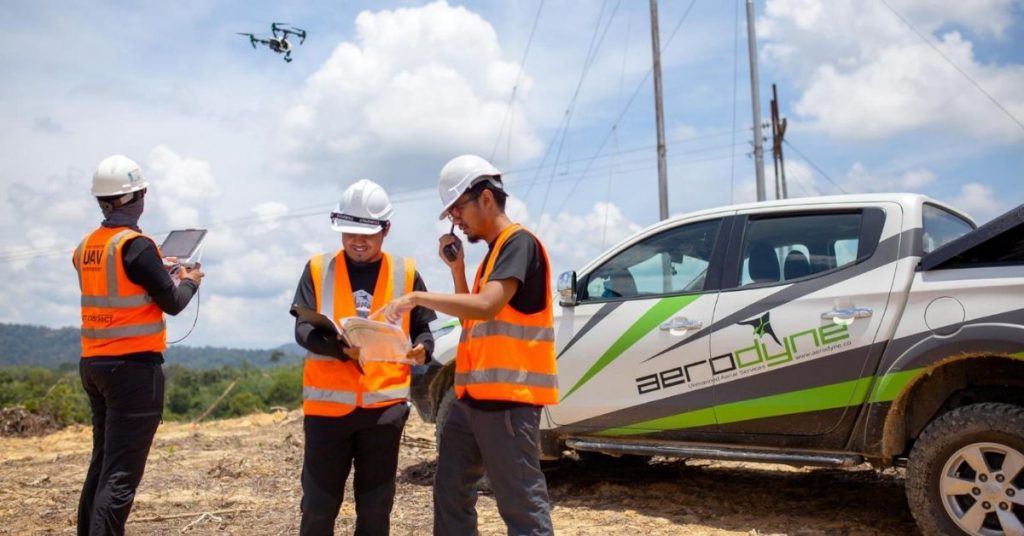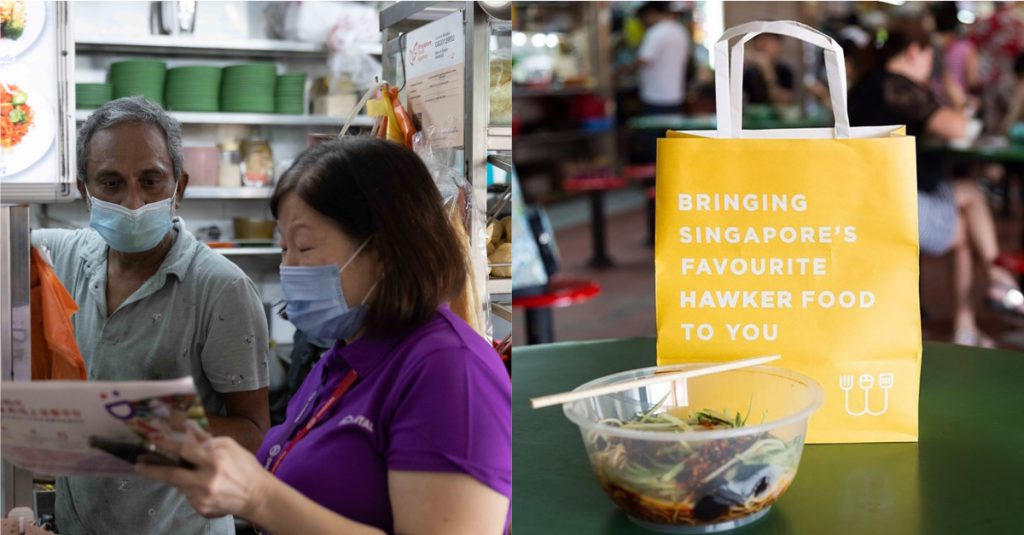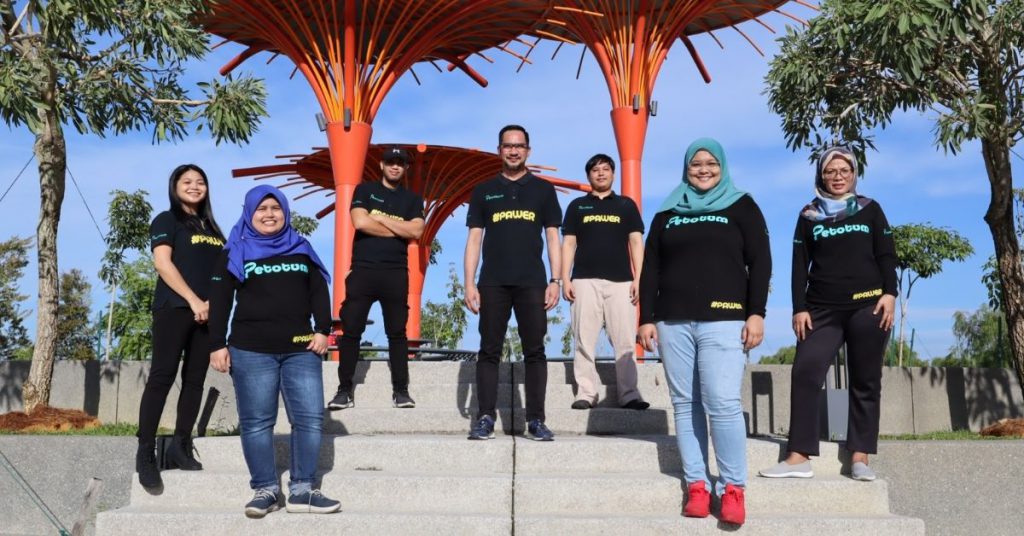Covid-19: WFH will be the default from Sept 27, wedding receptions allowed for up to 250 people

The Ministry of Health (MOH) announced today (Sept 24) that working from home will be the default for all employees who are able to do so. This will come into effect from September 27 to October 24.
Previously, a maximum of 50 per cent of employees who are able to work from home were allowed to be at the workplace at any point in time.
MOH said that there should continue to be no cross-deployment of workers to multiple worksites. Social gatherings at the workplace will also remain banned.
“Employers should continue to implement flexible working hours and stagger the start times of employees who need to return to the workplace,” it added,
The ministry noted that employees, contractors, and vendors who are unable to work from home are “strongly encouraged” to self-test weekly via an antigen rapid test (ART) to keep infected employees from going to work and keep their workplace safe.
MOH also noted that vaccination-differentiated safe management measures, mask wearing, and proper distancing remain “essential” to ensure that large events can proceed safely for attendees.
Event sizes will remain at up to 1,000 fully vaccinated attendees
Event sizes and capacity limits for congregational and other worship services, cinemas, MICE, live performances, spectator sport events will remain at up to 1,000 attendees if all are fully vaccinated.
Otherwise, only up to 50 attendees will be allowed without pre-event testing (PET).
“The concession for children aged 12 years and below, who cannot yet be vaccinated, will also apply for these events. Such unvaccinated children may be included in a group of up to two persons if the child is from the same household,” said MOH.
The ministry noted that there will be no change to measures related to marriage solemnisations, which are allowed to continue, with seating in groups of up to two persons, if all are fully vaccinated.
Home solemnisations will also continue to be allowed with up to 10 attendees. Otherwise, only up to 50 attendees will be allowed without PET.
“We acknowledge that wedding couples have faced significant uncertainties over the past few months. Hence, as a special concession, wedding receptions may be allowed to continue with up to 250 attendees if all are fully vaccinated, and with a group size of up to 5 persons per table,” added MOH.
“All wedding guests must strictly abide by the safe management measures, and in particular maintain social distancing and avoid mingling with others beyond their own table. Given their higher vulnerability, we also strongly discourage unvaccinated individuals and the elderly from attending such events, as PET only reduces their risk to others but not the risk to themselves.”
Featured Image Credit: NTUC Income
Also Read: Covid-19: Dining-in limit scaled back to two persons from Sept 27 to Oct 24
Covid-19: Dining-in limit scaled back to two persons from Sept 27 to Oct 24

Following the recent spike in Covid-19 cases, the Ministry of Health (MOH) announced today (Sept 24) that the group size limit for dining-in at food and beverage (F&B) outlets will be reduced to two vaccinated people from the current limit of five.
Unvaccinated individuals with a valid negative pre-event test result, recovered people, and children aged 12 and below may be included in the group of two at F&B outlets.
The rules for dining-in at hawker centres and coffee shops remain unchanged.
According to MOH, the cap on social gatherings will also be reduced to a maximum of two persons, from the current limit of five. Singaporeans should only attend one social gathering in a day.
Meanwhile, households can receive two unique visitors a day.
The new restrictions will start from September 27 and last until October 24. MOH will review the measures two weeks after implementation and adjust these measures based on the community situation then.
“We do not need to return to a heightened alert. But we have to do more to scale back social interactions further in order to slow down community transmissions and allow for better stability,” said MOH.
Entertainment such as live performances, recorded music, and videos or television screening at F&B outlets will continue to be prohibited, MOH said.
Featured Image Credit: Jorge Silva via Reuters
Also Read: GrabMart to airasia fresh: How well do these online grocery platforms in S’pore deliver?
M’sian startup Aerodyne ranks first in 2021 list of top global drone service providers

In a recent report by Drone Industry Insights (DRONEII), a drone market research and analytics company, Malaysia-based Aerodyne came out first in a list of the top 40 remote-sensing companies across the world.
This is the first time that Aerodyne has topped the list, previously hovering at second behind Japan-based Terra Drone in 2020. In 2019, it was third.
DRONEII determines these rankings by looking at the company size and development, market shares, and public attention as key parameters.
Over the years, Aerodyne has been steadily growing its presence across the globe and today operates in 35 countries.
AI changed the game
Aerodyne first started out as a drone division of a media company that CEO and founder Kamarul A Muhamed founded in 2006.
Come 2014, however, he turned the division into an entirely separate entity that we know of as today’s Aerodyne, focused on drone-based enterprise solutions. It had the sole objective of transforming visuals into data.
But soon, even that wasn’t enough. Kamarul wanted to up the ante, and so they added AI into the mix. This enabled them to expand the solutions across more industries, be they construction, agriculture, oil & gas, etc.
In the span of just one year, their AI and software development team grew tenfold to support the company’s ambitions.
Today, it’s known as a DT3 enterprise solutions provider. To break it down, DT3 stands for drone technology, data technology, and digital transformation.
Rapid global growth
Over the past 7 or so years, Aerodyne has seen massive and rapid growth. This is thanks to a flexible strategy comprising mergers and acquisitions (M&A), direct market entry, and identifying local players in those markets to create joint ventures.
In December 2019, Aerodyne formed a new business entity, Aerodyne Measure Inc, to serve enterprise clients in North America after acquiring a 60% stake in Measure UAS Inc.
The following year then saw the Malaysian startup acquiring Falcon Eye Drones in the United Arab Emirates, which ranked fifth on the global remote-sensing drone service providers of 2020.
More recently in 2021, Aerodyne expanded to Thailand after the launch of a joint venture company AeroSky (Thailand) Company Limited with AI and Robotics Ventures Company Limited (ARV) and Digital Creation Co Ltd (DC).
These are just some examples of the startup in action, and it’s clear that Aerodyne has no plans of slowing down.
Recognitions of the company’s trailblaze also include a recent EY Entrepreneur Of The Year 2020 Malaysia award being given to Kamarul, along with a win in the Technology Entrepreneur category.
Towards a drone economy future
Locally, Malaysia’s strict regulations of unmanned aerial vehicles (UAVs) have dampened breakthroughs in the dronetech industry, but we’re slowly seeing change.
We had our first Drone Testing Zone (DTZ) set up in Cyberjaya in July 2019, and as of June 2021, its impact report shared that over 216 flights with more than 432 total flight hours had taken place at the DTZ.
Earlier this year, AirAsia also began its pilot project for the drone delivery of goods from its e-commerce site, made possible by the Urban Drone Delivery Sandbox.
In a previous interview with Kamarul in 2020, he disclosed to Vulcan Post that the growth of Malaysia’s dronetech industry is the responsibility of all stakeholders, adding that he envisioned us having a drone economy in the near future.
He described a drone economy as a time in the near future where drones are a part of everyday life, for deliveries, safety, hobbies, and even virtual tourism.
“This is a vision of 3-4 years away, but before we get there, we need to have public acceptance. The technology is already there,” he said.
According to DRONEII, the global drone market size is forecasted to reach US$41.3 billion by 2026 at a 9.4% compound annual growth rate (CAGR). It spells a huge opportunity for Aerodyne to continue its dominance in the market, particularly in the remote-sensing sector.
Based on its track record thus far, any confidence in Kamarul and his team to continue extending their reach into all 4 corners of the world will not go misplaced.
Also Read: 9 facts about personal loans in M’sia you should know to borrow responsibly in a pandemic
Featured Image Credit: Aerodyne
M’sian femtech focuses too much on periods & fertility, this startup is out to change that

Meera is no stranger to dealing with the frustrations of finding proper solutions for her hormonal imbalances and irregular periods that weren’t just temporary fixes to suppress symptoms.
Once she started opening up with her struggles, she found many other women in her circle battled similar health conditions. Meera’s university friend, Rinisha also noticed her own close circle struggling to find help to manage or treat their polycystic ovarian syndrome (PCOS).
When Meera and Rinisha reconnected years after graduating, this topic of underserved female healthcare came up over brunch, and they lamented that they were not in the health field.
“And then we had an aha! moment and were like wait, we may not be certified as health practitioners but we do have skills and experiences that could potentially make a difference for women out there,” they told Vulcan Post.
With this decision, Meera brought her consulting and startup experience to the table while Rinisha contributed her medical bioscience and SME marketing knowledge, and together, they set about creating Citayana Being.
They plan to officially launch around December 2021.
A common issue that’s still largely unaddressed
Citayana Being has its core focus on PCOS, and the duo explained it’s because the chronic condition is the most common hormonal disorder among women, with 1 in 10 suffering from it.
However, it’s also difficult to diagnose and the resources and means to manage it are scarce. Without proper care management, PCOS can develop into serious health issues such as infertility, type 2 diabetes, endometrial cancer, and more.
One of the major difficulties with diagnosing PCOS is due to the different symptoms each individual may have. “Most women waste years and hundreds, if not thousands, of Ringgit visiting more than 3 practitioners on average in pursuit of getting a diagnosis, effective care management, or supplements,” Rinisha and Meera said.
Then there’s the fact that PCOS diagnosis, care, and treatment aren’t covered by insurance unless one needs to surgically remove cysts in their ovaries.
“At Citayana Being, we want to help women identify and navigate PCOS and other hormonal imbalances by increasing earlier diagnosis and providing coordinated, holistic, and personalised care to manage their symptoms,” the duo explained.
But don’t get it wrong, they’re not trying to replace a physical visit to a doctor’s office. Instead, what you’d get on the site would be a consolidation of verified practitioners consisting of gynaecologists, fitness coaches, dietitians, alternative care practitioners, and more.

“The key things we look at are their knowledge with PCOS, experience in treating patients with PCOS, and their accreditations,” they shared, adding that of course aligned values mattered too.
“Understanding each practitioner’s approach to care management is also done to ensure it is something sustainable for women, that it empowers and enables them to continue the journey on their own in the long run.”
Going beyond menstruation & fertility
When speaking of femtech in Malaysia, a lot of the existing solutions tackle menstruation and fertility. Beyond those markets, other female issues remain underserved.
Dictionary Time: Femtech refers to software, products and services, and diagnostics that use technology to improve women’s health.
“Besides that, many women-focused issues that have opportunities for femtech development were topics that were stigmatised and, to a certain extent, still are today,” the duo shared.
These are just a few reasons why it’s taken this long to see changes. Thankfully, awareness is on the rise now, with more conversations ongoing and platforms emerging. The duo likened it to the way mental health awareness developed locally over the years.
Rinisha and Meera can onboard all the professionals and experts they want on their site, but without the trust of users, there will be little use for the solutions offered.
That it’s a healthcare site means that trust is all the more paramount, which could be a challenge for the new startup. To overcome this, the team will provide touchpoints where users can opt for an initial free consultation to experience the site, after they’ve signed up or joined the waitlist here.

“With health, each person’s needs, preferences, and goals are different and besides seeing if we are able to meet theirs, it is important for them to decide if we can live up to their expectations but also are comfortable with us,” the duo said.
Citayana Being’s packages will address the 4 types of PCOS: insulin resistance PCOS, adrenal PCOS, inflammatory PCOS, and post-pill PCOS.
With the variety of professionals on their site, users will be able to pick between conventional medicine approaches, alternative ones, or a blend of both to suit their needs.
Because there is no one-size-fits-all treatment for PCOS, the pricing range of packages would differ, and the team will provide updated prices upon launch.
Much more could and should be done
Leveraging key partners that are already impacting women’s healthcare will be one way that Rinisha and Meera foresee Citayana Being’s growth scaling, aside from word-of-mouth marketing.
By working with specialised solution providers, the startup could also contribute to addressing financing help for PCOS diagnosis and care, for example.
Of course, there are also many other gaps in terms of products and services that serve women in different life stages, with regards to their sexual healthcare, postpartum care, baby care, and menopause care.
While Citayana Being didn’t specifically say that they would venture into these spaces per se, Meera and Rinisha acknowledge the many opportunities out there for the taking.
It would be really interesting to see devices created for early detection of breast cancer or ovarian cancer. Another area would be developing drugs more suitable for women; currently women are underrepresented in clinical trials for new medication and this sometimes results in women having more side effects to drugs due to incorrect dosages or biological differences. One can only imagine how big the market size would be if that were done.
Rinisha Devi Vijayen & Meera Maniar, co-founders of Citayana Being.
Also Read: Laptop subscription services exist, but this M’sian company added on software and IT support
Featured Image Credit: Rinisha Devi Vijayen & Meera Maniar, co-founders of Citayana Being
Get 30% off your food & groceries while supporting small businesses on Grab this September

[This is a sponsored article with Grab.]
With 80% of Malaysian adults now fully vaccinated, businesses that were previously closed physically such as food courts, malls, markets and even cinemas can go back to operating as normal.
That said, the norm that we’ve come to know has to continue and that means wearing masks, social distancing, and not crowding up physical spaces. And if you’ve gotten very used to staying inside, like many of us, there are promotions available that allow you to still support small businesses from the comfort of your home.
For example, Grab is currently running a 30% off for small businesses on their platform on GrabFood and GrabMart, from 24 to 30 September, 2021.
Hyping up the small F&Bs
If you’re tired of the same ol’ fast food that you’ve been having ever since the lockdown started, Grab actually has an extensive list of small businesses. Especially during the pandemic, many of the traditional and small businesses have hopped onto the platform.
The Bassment [Non-Halal] is one of the local restaurants that has been operating even before the pandemic. It is run by two deaf brothers, and a younger, abled brother. Their menu primarily consists of Asian-western fusion dishes, and they have a variety of coffee and cakes for the tea time crowd too.

But if you’re in the mood to dig into more local flavours, Kadei by Manchula can be a good shout too. They started their operations during the height of the pandemic back in August 2020. They offer a range of Malaysian-Indian cuisines ranging from Indomie Lamb Chop to the classical banana leaf rice or lamb biryani.
Did you know: Kadei by Manchula’s name was inspired by the Tamil pronunciation of ‘shop’, and a play on the word kedai in Malay.
However, if heavy meals are not your cup of tea, you could also consider picking up a bao from The Bao Guys. As their name suggests, they focus mainly on baos. From a quick glance on their menu, they look to be pork-free. They currently offer chicken, tofu, shrimp, lamb and beef baos.
For the week of September 24 to September 30, 2021, you can use the code PENIAGAKECIL on your orders to get 30% off your order from the businesses above.
Delivering essentials and groceries right to you
But if you’ve only used Grab for GrabFood, they actually have a large list of businesses under GrabMart for your daily essentials.
For example, Khairul Gracewood Enterprise located in Pasar Besar TTDI is a butchery offering a variety of local and Australian beef, along with select cuts of lambs. So you won’t even have to step out to get fresh meat to cook with.
And if you have a special occasion coming on, you can also order from 21st Flower Bar on GrabMart. While they’re called a flower bar, they don’t really sell cocktails or drinks. Instead, they sell preserved dried flowers, soap flowers, fresh flowers, candles and jewellery.
Let’s say that your significant other is not a fan of flowers; you can then opt to buy them brownies from Brownies Bar by The Accidental Bakers. They have a wide mix of brownie flavours ranging from salted caramel, peanut butter, cookies & cream and others.
Just like the F&B shops on GrabFood, you can also use the code PENIAGAKECIL to get 30% off your orders for these small businesses.
-//-
Here’s how the promo works when you use the code PENIAGAKECIL:
- GrabFood: 30% off up to RM8 with a minimum order of RM20,
- GrabMart: 30% off up to RM9 with a minimum order of RM30,
Note that the promotion is only until 30 September 2021. There are a lot more other small businesses that are also part of this promotion. You can check the full list on Grab’s site here to find one near you.
- Use promocode PENIAGAKECIL to get 30% off your orders.
- Find out more about the businesses available via the Peniaga Kecil Promo here.
- Download Grab for iOS and Android.
Also Read: 9 facts about personal loans in M’sia you should know to borrow responsibly in a pandemic
Featured Image Credit: Grab
The small glow at the end of a cigarette that could affect 5 mil M’sian smokers

In July 2021, the WHO (World Health Organisation) released a report stating that there are 1.3 billion tobacco users worldwide. And locally, they estimate there are currently 5.3 million active smokers in Malaysia.
A published finding from the MOH (Ministry of Health) details that in 2011 to 2015, the number of smokers has gone down from 23.1% to 22.8% respectively. This can be attributed to the government’s anti-smoking efforts, to realise the vision of Malaysia as a smoke-free nation by 2045.
The government’s approach of implementing anti-smoking policies (e.g. explicit warning messages on cigarette packs) and regulations that aim to reduce the risk of second-hand smoke exposure (by banning smoking in public spaces) seemed like one that was heeded by the nation.
BuBut what is less common in their approach is providing information about the main harmful component of cigarettes, which includes the composition and the actual combustible reaction.
A spark is all it needs
When a cigarette is lit up and combustion occurs, it can reach a burning point of up to 900-degrees Celsius. At that moment, up to 7,000 chemicals can be released from the smoke. And of those chemicals, 250 of them are known to be harmful.
Did you know: The highest combustion point of a cigarette can even potentially ignite diamonds.
That said, these chemicals are not only present in cigarettes. They can also be found in common household items such as batteries (cadmium, lead), gasoline (benzene, rubber cement), lighter fluid (butane), nail polish remover (acetone) and paint (chromium).
When these chemicals are ingested, or burned and breathed in, they can pose a risk to the human body and the surroundings. This is why certain household items such as batteries and gasoline have visible “do not burn” or “do not dispose as domestic waste” warnings on them.

Some sources believe that out of the 250 toxic chemicals, 50 of them can lead to not just lung cancer, but other cancers as well. In cigarette smoke, you’ll find common gasses such as carbon monoxide, nitrogen oxide and hydrogen cyanide in them, which are harmful too.
Cigar smoke also shares the same toxic and carcinogenic (cancer-causing) chemicals as cigarette smoke. Due to how they’re made and wrapped, cigars even have potentially higher concentrations of nitrogen, which can provide a stronger nicotine delivery.
Contrary to what some might believe, nicotine by itself does not cause cancer. But, it is an addictive chemical that keeps people hooked. Nicotine provides the user with an adrenaline and dopamine rush when inhaled.
Clearing the cigarette ‘air’
With combustion being the spark, some of the chemicals below either make smoking more addictive, or they’re the main causes of harm when ingested.
- Additives
Additives can provide a smoother smoking experience. Some of the common additives in cigarettes come in the form of flavourings and menthol. Menthol provides a cooling sensation when inhaled, numbs the throat and reduces the harshness of the inhaled smoke.
The American FDA (Food and Drug Administration) also found that other additives like ammonia in cigarettes can optimise nicotine delivery, making it faster for the body to absorb nicotine.
- Tar
Another common misconception is that ‘tar’ in cigarettes refers to road tar, but this is not true. Tar is an umbrella term in cigarettes, referring to the toxic smoke that is created when a cigarette is burned. When this toxic smoke is inhaled, the tar then forms a sticky layer that coats the lungs.
Tar contains most of the carcinogenic chemicals in it, and will lead to the damage of lungs, which can be commonly seen on cigarette packaging.
The rise of the alternatives
There’s also been an increase in the adoption of smoking alternatives such as e-cigarettes, vape, heat-not-burn (HNB) devices (also known as heated tobacco products) and others. These alternatives can be a less harmful option and because of them, there are less people smoking combustible cigarettes.
But, they do not completely negate the risks of smoking. For example, e-juices used in vaping devices can still contain nicotine (which can be addictive). And e-juices have more flavourings compared to traditional cigarettes too, which is enticing for younger folks.
Note: Nicotine can be vaporised at temperatures of (around 200 to 250-degrees Celsius), thus vapourisers such as e-cigs and vapes can deliver nicotine to smokers without burning.
HNB devices on the other hand, do not go through a burning process. Instead, HNB devices heat up tobacco sticks to a maximum of 350 degrees Celsius. By eliminating the combustion process, HNB devices release less toxins in its vapour as compared to cigarette smoke.
However, vaping and HNB’s long-term effects are yet to be studied extensively, and risks are still present for those who smoke.
Users of these smoking alternatives are still subject to chemical reactions from inhaling the vapours, but they’re generally recognised as less harmful options compared to traditional combustible cigarettes.
For example, officials from the United Kingdom and New Zealand view vaping as a less harmful way of delivering nicotine. It is also one of the ways to slowly get a person to quit smoking.
It can’t be denied that not smoking is the best choice. But for those who wish to continue, knowing the choices they are making and the risks they’re taking, allows them to make better and more informed decisions.
Also Read: Alibaba Cloud was a star player behind the scenes in this year’s Tokyo Olympics, here’s how
Featured Image Credit: Donny Jiang on Unsplash
Deliveroo, FoodPanda, Grab, WhyQ to help S’pore hawkers go digital at no fees under new pilot

It’s no secret that the F&B industry has taken a serious hit during the Covid-19 pandemic.
As more F&B businesses pivot online to cope with the dipping sales, older hawkers are at a disadvantage as they struggle to adapt to multiple online delivery platforms.
To help our local hawkers tide through these difficult times, SG Together Alliance for Action (AfA) – Online Ordering for Hawkers has announced two pilot programs.
By the end of this year, various delivery platforms will be participating under a common acquirer model program. The pilot will cover 400 stalls across 14 hawker centres in Singapore.
Under this scheme, consumers will have the option to mix and match food items across stalls for bundle orders, which are put together by centralised hawker captains who will interface with the hawkers directly.
Under this model, WhyQ — the common acquirer for hawkers — will use its existing relationships with hawker stalls to onboard them onto Deliveroo, FoodPanda and Grab, such as uploading their menus onto the platforms.
Hawkers will have easy access to all customers of participating online ordering platforms and will enjoy the convenience of an integrated interface to receive and manage orders from all platforms.
Orders will be received either through a single device, or on-site Hawker Captains at each hawker centre who will be tasked to place and coordinate orders.
WhyQ will manage transactions and payments to hawkers, with same-day payments and no commissions charged to hawkers. Consumers can access a wider selection of hawker stalls through their preferred online ordering platform.
The best part is that hawkers will not be charged commission fees or onboarding fees.
More digital support for hawkers

In addition to the common acquirer program, the National Environment Agency (NEA) has set up a Digital Support for Hawkers (DSH) to develop a set of best practices for hawkers.
The NEA and SG Digital Office (SDO) launched an awareness and education campaign to help stallholders understand how to supplement physical transactions with online ordering options.
Between June and September, SDO Digital Ambassadors has engaged 5,500 hawkers.
Hawkers will get further targeted support to help them benefit from going online, with new initiatives by the SG Together Alliance for Action (AfA) – Online Ordering for Hawkers.
This includes creating a Facebook page for each centre, facilitating community group buys through the Facebook page and organising tie-ups with organisations to make bulk meal orders.
This group will provide support to help less digitally savvy hawkers improve their online presence. Meanwhile, the DSH group will provide peer support to help less digitally savvy hawkers embrace digital opportunities.
To date, 30 hawker centres have expressed interest in piloting this initiative from October to December 2021.
VP Label puts together all the best local products for you to discover in one place. Join us in supporting homegrown Singaporean brands:
[iframe_vp_product src="https://vulcanpost.com/label/embed-all/" id="iframe1"]
Featured Image Credit: IMDA / WhyQ
Also Read: Rent, salaries, Covid-19 testing: How F&B bosses are coping with restrictions
Winners and losers of COVID-19 in S’pore’s labour market: Which industries keep hiring?

One of the least widely understood areas of every economy is its labour market — particularly as the media tend to focus on a single figure when describing its situation — the unemployment rate.
On-the-ground reality, however, cannot be summarised with just one number as each industry faces its own challenges, which create unique conditions for jobseekers.
This has now been exacerbated by the COVID-19 pandemic, which has affected each industry in a completely different way.
* All figures cited below are from official datasets available on MOM website, unless otherwise stated.
Stability on the surface
Unemployment in Singapore nudged up Q2 from 2.7 per cent to 2.8 per cent (and 3.5 per cent to 3.7 per cent for resident workforce) — what is still an improvement over 2020.
It is also much better than in most of the Western countries — about five per cent in Britain, six per cent in the US, eight per cent in France, or a whopping 15 per cent in Spain.

Moreover, this bump is likely due to the reintroduction of temporary restrictions in the city-state, which forced employers to lay off staff in the most affected business — and should have already gone down in Q3 as Singapore decided to “live with Covid”.
After all, even during “normal” times, a change of 0.1 to 0.3 per cent was nothing unusual.
However, what these figures are not telling us is what the situation looks like for specific industries and companies. It is there where COVID-19 has left a significant impact — both bad and good — accelerating qualitative change in the entire labour market.
Winners of the pandemic: IT & Finance with close to 15,000 new jobs
IT and insurance are the only two segments of the market which have not seen a contraction in employment throughout the entire pandemic. Hiring slowed down in Q2 of 2020, but remained positive, while everybody else was facing some degree of layoffs.
On the whole, since the beginning of 2020 until today, close to 10,000 people found employment in IT & Communications — with Q2 of 2021 responsible for a whopping 3,600 new jobs, the highest quarterly figure on record.

In total, around 6,200 people found employment in the tech sector in the first half of 2021. This is nine times more than in H1 2020 and by far, the most in recent history (the second highest tally is 3,300 recorded in H1 of 2013).
Meanwhile, financial and insurance services — a staple of Singaporean economy — have also recorded gains in employment, netting 4,100 jobs since the beginning of 2020.
While not as impressive as the technology sector, it is still a healthy gain in some of the best paid professions in the country. Among other gainers are professional services, chiefly legal and admin, which now provide employment to 2,100 people more than before COVID-19.
In other words, some of the most sought-after office careers have not been dented by the pandemic.
Strong performers: Health, Education and Public Administration
Other areas that saw comparatively large gains are unsurprisingly the healthcare sector (12,600 jobs) and Public Administration & Education (close to 10,000 more than at the end of 2019).
Transportation has also seen an uptake, adding over 3,000 jobs, boosted by greater demand for delivery services.
I have decided to mention them separately, as their future is quite uncertain, depending on how the pandemic continues to affect our lives. High demand for new workers in healthcare is an obvious consequence of the strain the virus has put on hospitals and clinics, as well as the need to adhere to new safety protocols.
Similarly, public administration needs more people, among other things, to take part in the pandemic response and provide services to both companies and individual residents that were not necessarily prior to the outbreak.
But whether these jobs are here to stay remains to be seen. Nevertheless, they have provided a healthy boost to domestic employment in a time of need, particularly among Singapore residents (citizens and PRs).
Biggest losers of COVID-19: services, construction, manufacturing and… foreign workers
Frankly speaking, I should probably just write “everybody else”, since outside of the ones I mentioned, pretty much all industries have shedded jobs.
That said, the most impacted ones are, quite obviously, those requiring large numbers of people either working together or interacting with customers which, in both cases, was severely restricted by the social distancing rules or outright lockdowns.
Services (excluding those I mentioned above) saw a drop of 120,000 jobs. In construction, another 56,000 are gone, followed by manufacturing with 46,000.
It is important to underscore, however, that vast majority of the affected workers were not local but foreign. Collectively, they have borne the brunt of the pandemic in Singapore.
By the end of 2020, resident employment actually went up by about 15,000 jobs compared to the end of 2019. Within that same time, close to 200,000 foreigners had lost their jobs in the city-state.
This trend continues in 2021, with non-residents losing 21,000 jobs in Q2 of 2021:

Cuts have hit the lowest-paid workers and domestic helpers the most, but S- and Employment Pass (EP) holders have not been spared.
At the end of 2019, Singapore had 193,700 EP and about 200,000 S-Pass holders. By the end of 2020, these figures dropped to 177,000 and 174,000 respectively. Their decline has continued into 2021, as they dipped to 167,000 and 164,000 this June. It’s an accumulated loss of over 62,000 jobs paying at least S$2,500 or more.

Singapore will see better times ahead
With the reopening of the economy and gradual easing of the border restrictions, as Singapore begins “living with Covid”, employment should record a stronger bounce-back — and there are already indicators of this acceleration in the current Q3 of the year.
A research study by Indeed registered a 55.7 per cent jump in job postings in August 2021, as compared to pre-pandemic figures for 1 February 2020.
Job creation in production, transportation and installation and maintenance was up 125 per cent, 109 per cent, and 89 per cent in August respectively, when compared to February 2020.
Not only is employment returning — it is doing so at a pace that is favouring jobseekers who are likely soon to be inundated with options, after many months of desperate job search, in some cases.
Indeed’s APAC Economist, Callam Pickering, was quoted by “Staffing Industry Analysts” saying (about Singapore):
“Competition for talent is increasing monthly and shows no sign of easing. Market dynamics for many occupations have shifted towards the jobseeker, potentially leading to greater choice for job seekers and higher salaries.”
“As the economic recovery continues, we expect skill shortages to either develop or become exacerbated across a broader range of occupations that may create a more challenging hiring environment for businesses and recruiters.”
Official government data for the earlier quarter appears to be confirming this trend, as vacancies have — for the first time since March 2019 — outstripped the number of people looking for a job.

With tens of thousands of foreigners gone — many losing relatively well-paying positions — while significant border restrictions remain in place to keep COVID-19 out, the number of good job opportunities for the locals may be highest in years.
That said, it’s no guarantee of employment if not enough people in Singapore are qualified to fill them. Of course, every year brings thousands of new graduates, for whom it may be a golden opportunity (particularly after more than a year of uncertainty about their careers).
But if there’s a significant mismatch between skills required for the position and the competences of candidates, Singapore may move from an employment crisis to a labour crunch, strangling businesses that are trying to get back on track as quickly as possible.

Back in July, Minister Tan See Leng mentioned there were already 22,000 vacancies in the PME professions that companies were struggling to fill. With the latest hiring spree, these figures may quickly increase in Q3, slowing down hiring and, consequently, Singapore’s economic growth.
Understandably, the perspective of having way more openings than candidates must seem very attractive to everybody looking for a job, but it’s one of the worst problems for companies — and just as bad for the country as unemployment is.
Economy needs to be as close to the right balance as possible to function well, with a sufficient number of vacancies to allow people find good jobs (and companies the right employees) quickly. Every mismatch between the supply of and demand for labour can cascade into nationwide economic crisis.
Singapore is succeeding in the qualitative shift thus far
As I mentioned before, COVID-19 pandemic has accelerated a qualitative shift in Singapore’s labour market.
The most affected industries are actually those that pay employees the least, or which had already suffered from international low-cost competition even before 2020.
Meanwhile, advanced services appear to be doing well. It is particularly interesting as the pandemic has also promoted a work-from-home model, in which it doesn’t really matter if your employee is five or 5,000 miles away.
Despite this change (and obvious cost pressures in a tough economic environment), Singapore is adding employment in IT or finance, which suggests that its competitive advantages remain strong and it can hold its own even if employers can technically employ a remote foreign worker for half the price.

The question remains whether employment in the most affected sectors is going to return to pre-pandemic levels, particularly in manufacturing and many services (construction is safe as it happens locally).
In 2020, manufacturing companies lost 37,800 jobs, including around 10 per cent (3,600) locals. This trend continues throughout 2021, and may last for a while longer.
Panasonic has just announced it would lay off 700 people and close its refrigeration manufacturing plant next year, moving jobs to Malaysia and China. Can they be replaced with other investment? It’s impossible to say yet.
Elsewhere, in-person retail has seen many stores closing and/or moving their operations online. They are unlikely to return, creating a cascade of consequences — from higher employment in IT services, to more empty spaces in shopping malls, downgrading future construction in anticipation of more retailers going digital, to outsourcing a lot of the work abroad (since it doesn’t matter where staff running an online shop is located).
Early figures suggest that Singapore is doing well, but it’s too early to say whether this trend continues over the long-term.
As I argued in my previous article, Singapore is exceptionally well regarded for its handling of Covid-19 and is reaping rewards thanks to the trust it has gained during the height of the pandemic last year as well as its dedication to resume business as usual right now.
Growing employment in certain services (while exodus is seen in for say, in Hong Kong) suggests that the city-state is a priority choice for international business in post-COVID Asia.
However, it is going to take at least a few years for the situation to settle in this new reality — and if the local workforce is not quick enough to adapt, companies may move either themselves (or many of their jobs) out of the country in the end.
After all, it has never been easier than it is now.
Featured Image Credit: Maverick Asio/SOPA Images/LightRocket via Getty Images
Also Read: S’pore is turning COVID-19 into gold, attracting global businesses with pandemic policies
No upfront cost, interest, contract: StarHub’s EasyGo lets you get your dream phone easily

When it comes to phone plans, it’s always a debate between a sim-only (SIMO) plan and contract plan. According to Asia Insight’s research, about one in two (47 per cent) are on SIMO plans without mobile phones.
A SIMO plan is preferred if your phone is in relatively good condition and if you don’t want to be tied down with a contract. However, a SIMO plan might appear cheaper at first glance, but when you add in the cost of a new phone, it does amount to a king’s ransom.
Even though the cost of a phone from a telco and a distributor is the same, SIMO customers feel that phones from telcos are more expensive.
Therein lies the Catch-22 — if your phone is outdated and when you want to upgrade it, judging from the prices of phones these days, it might help if you have an inheritance waiting.
SIMO plans allow you the wiggle room, but it is particularly costly to upgrade your phone to a newer model.
Another reason why contract plans are preferred might result from social norms where customers are used to buying handsets with two-year plans from a telco. It’s 2021, and it’s time to take charge of your phone plan and get yourself closer to that dream phone that you’ve been yearning for.
Being the innovative telco giant that they are, StarHub is changing up the game with the launch of EasyGo.
EasyGo is an improved monthly instalment payment method that only applies to their SIMO — no contract plans or one-year plans, making it easy for you to get your hands on whatever phone you want.
To make things easier, we’ve broken down three key reasons why you should sign up for EasyGo:
No upfront cost
The first thing you have to love about StarHub’s EasyGo is that there is no upfront cost. When you purchase your SIMO plan, you canopy for your bite-sized monthly instalments over 12 or 24 months.
If you are an existing StarHub mobile customer looking to switch to a SIMO plan, you can use your loyalty voucher to offset the payment of the device of your choice at the point of re-contract to a SIMO plan with EasyGo.
With phones costing a pretty penny, you don’t want to fork out more unnecessary money on your phone when you could be taking a cruise or spending on a meal at a fancy restaurant.
EasyGo basically acts as a buy now, pay later option. It’s a win-win option: you get more flexibility in managing your finances, and at the same time, you can instantly get your hands on the phone you want.
No minimum contract
Like one of our great new-age philosophers, Lizzo proclaims you don’t want anything to hold you back when you’re living your best life.
That’s the same thing StarHub EasyGo wants for you. With no minimum contract, you’re not tied down and have the flexibility to pay with this payment instalment plan.
With EasyGo, you can decide to clear all instalment payments early at one go without any termination, administration, or other hidden fees.
Plus, you retain full ownership of your device — that’s the real cherry on top.
Also, if you are one of those people that need several phones (for business and personal use), you would be pleased to know that you can opt for EasyGo for up to six lines.
No interest
The thing about interest is that it is usually not in your interest. With StarHub’s EasyGo, they are thinking about you by having no interest fees.
After all, adulting is by no means an economical endeavour. With new bills to pay and the rising housing costs, having these bite-sized monthly instalments at zero per cent is one less thing to worry about, for sure.
This way, you don’t have to eat a month of instant noodles to meet those interest fees.
How to sign up for EasyGo?
If you’re still on the fence, hop off it and join the side where the grass is indeed greener with StarHub.
With the convenience of StarHub EasyGo and the customisable features of SIMO plans, the answer is as clear as the Super Retina XDR display of your new phone.
Get your dream phone at S$0 upfront without a contract, and pay for it in bite-sized instalments with zero interest. Sign up for StarHub’s SIMO plans with EasyGo here.
This article was written in collaboration with StarHub.
Featured Image Credit: StarHub
Also Read: StarHub to acquire 50.1% stake in MyRepublic’s broadband business for initial sum of S$70.8M
From cat lovers to technopreneurs, it’s a journey that started with a pet hotel in M’sia

[Written in partnership with MaGIC, but the editorial team had full control over the content.]
In 2017, Afifah and Shifa’s pet boarding service was recognised as the first pet hotel in Malaysia to implement a 100% online booking system. Their efforts won them awards including Site of the Month and Site of the Year for the e-commerce category in 2018 by Exabytes Group.
The duo got into the pet hotel business in 2017 purely because they wanted to surround themselves with cats. With limited funds, manpower remained lean, so they needed a system that could manage the operations at Meowclass Cat Hotel & Grooming (Meowclass).
Upon research, they weren’t able to find an existing booking platform to use, they claimed. So, with Shifa’s self-taught Python knowledge, she built a website complete with booking and simple service management systems to help run the hotel.
“We saw the potential to expand our brick and mortar business and we were looking for advice from a successful entrepreneur to raise funds from investors,” they recalled.
“We totally overlooked that we had a potential tech solution on our hands, and [we were] advised to focus on growing our solutions so that we can help other pet hotel operators to run their business as we did.”
After visiting other pet hotels to validate their idea, Afifah and Shifa shuttered Meowclass in June 2019 to focus all their efforts on a building digital pet platform, Petotum.
From IRL to URL
Malaysia doesn’t lack pet boarding marketplaces, with popular names like JomPaw and Petbacker. Although Petotum started as a direct competitor back in January 2019, Afifah and Shifa were still trying to find their product-market fit before launching publically.
They were able to do so after joining MaGIC’s Global Accelerator Programme (GAP) to identify gaps they could fill. The result of that was Petotum being founded as a SaaS for pet boarding and grooming businesses to manage their operations.
While participating in GAP, Petotum went on to win TERAJU’s Superb competition which awarded them a grant worth RM500,000 in November 2019. It was the duo’s first pitch for funding under MaGIC.

Due to the pandemic, Petotum’s official public launch was delayed to December 2020.
Editor’s Update: The above paragraph has been edited for clarity.
But since then, the digital pet platform hasn’t slowed down and has been expanding its team, products, and services to serve consumers too.
Expanding amidst the MCOs
One of Petotum’s functions that users may find worthwhile—other than its booking services—is its digital database to keep track of a pet’s medical, dietary, or behavioural information.
It’s most beneficial when a pet is being looked after by someone else, or when a rescue animal is rehomed with its new adoptive family.
A link and QR code is provided in the app for users to share the recorded details in the app. Petotum doesn’t limit the number of pets listed per user, and the app is free to use.
This function came about during the MCO when Afifah was fostering 7 cats, in addition to the other 6 she already owned.
“When we rehome our foster cats to their new families, there is no way (other than on paper) to document the pet’s information that can be shared with the new owners. So, we figured that we have to do something about it and we did,” they told Vulcan Post.

Furthermore, to support pet services and stray animals amidst the MCO, Petotum launched its Bulu-Bulu Initiative to feed the strays. Pet food is funded by donations within the community, where Petotum’s volunteers will aid in feeding the strays.
In July 2021, Petotum also launched the Petpreneur Programme to help pet services digitalise their business. It had allocated RM1.5 million worth of pet care management solutions to over 500 Petpreneurs around the country.
These initiatives were part of the startup’s efforts to ease the burden for pet-related businesses impacted by the pandemic, while also reducing infection rates through digitalisation.
Already recording explosive growth
Within 2 years of its conception, Petotum has grown to offer 3 products. They include the digital pet database mentioned above, along with appointment and payment systems called PetotumBIZ (for groomers and hotels) and PetotumVET (for veterinary clinics).
The platform monetises through service fees from transactions made on Petotum’s app.

“If we take a step back and look at our achievements for the past 2 years, we have grown so much from a simple marketplace platform to an integrated platform for the pet ecosystem. We hired all our team members, built and launched our solutions, all during the pandemic. This is our biggest achievement so far.” Afifah, co-founder of Petotum.
To date, Petotum is currently servicing close to 10,000 pet parents and furbabies since its official launch in December 2020.
Petotum’s app has seen its highest growth rate of 174% while PetotumBIZ has recorded a 250% Month-over-Month growth in August 2021 since its launch in March 2021.
-//-
As of late, we’ve seen the public growing fond of pet ICs, pet insurance, and even fine dining meals for pet celebrations. This points to the willingness of owners to spend more money on their pets and find novel ways to care for them.
Petotum came at an opportune time for both pet parents and pet-related businesses, which likely led to its explosive growth upon its public launch.
However, to retain users, the platform would require some form of retention element to keep users active on the app as opposed to a one-off download, try, and delete situation. Perhaps having some form of a membership system with loyalty rewards via collected points could be its way forward.
Also Read: 9 facts about personal loans in M’sia you should know to borrow responsibly in a pandemic
Featured Image Credit: Afifah Basir and Shifa Azahar, co-founders of Petotum
Visa accelerates its crypto ambition with new S’pore hire to drive crypto solutions in APAC

Visa is hiring a Senior Director role in Singapore to drive crypto solutions in Asia Pacific.
The person will support crypto business development activities and infrastructure partnerships in the region, with the goal of continuing to grow the financial services firm’s position in the markets it serves.
The role includes generating new revenue streams and delivering crypto solutions for Visa’s partners including banks, fintechs, merchants, crypto wallets, and exchanges.
He or she has to serve as a subject matter expert both internally and externally, and lead the training for internal teams.
The person will also be tasked to scale emerging crypto product lines from initial proof of concept through go-to-market execution spanning pricing, strategy, deal structuring, and client support.

Visa growing crypto arm
Despite holding a market capitalisation of more than US$500 billion, the payments behemoth is trying to reposition itself amid fintech disruptions and the rapidly digitizing world.
The strategy extends to cryptocurrency. In recent years, it has been establishing relationships with crypto entities Coinbase, Circle, and FTX, among others, with the goal to make it easier for users of those platforms to buy products and services with their crypto. This also gives Visa new revenue opportunities.
In July, Visa revealed that it has partnered with no less than 50 crypto platforms via card programs that “make it easy to convert and spend digital currency at 70 million merchants worldwide.”
What’s more, the company revealed in the first half of this year, that it had facilitated more than US$1 billion in transactions via crypto-linked Visa cards.
Earlier this year, Visa doubled down on crypto business unit with five strategic hires and placements.
For more crypto updates and news to make sense of crypto and blockchain technology, you can visit our sister site chaindebrief and follow its Telegram channel here.

Featured Image Credit: Visa
Also Read: From DBS to Alibaba’s Ant Group: Here are 6 companies in S’pore that are hiring crypto roles
Electric Dream: Shell partners local firm to launch S’pore’s first fully-electric ferry service

Shell has awarded a contract to Singapore company, Penguin International Limited, to design, build and operate at least three fully-electric ferries.
When operational, these will be the first fully-electric ferry service in Singapore and a first for Shell globally.
Expected to set sail in the first half of 2023, the new 200-seater single-deck Electric Dream ferries will be used to transport passengers between mainland Singapore to Shell’s Energy and Chemicals Park on Bukom island, replacing the conventional diesel-powered ferries currently used.
The fully-electric ferries are powered by a lithium-ion battery system with a capacity of 1.2 MWh and run at speeds of over 20 knots with zero emissions and noise.
When berthed at Shell Bukom, the ferries will be charged via a combination of fast charging during peak hours, and slow charging during off-peak hours and overnight.
James Than, managing director of Penguin International Limited, said that the privately-funded project is much more than just electric ferries and shore chargers. It is in fact, Singapore’s first real-world commercial application of marine electrification.
“Shipping’s future will involve different parts of the sector using different fuels, and electrification is a solution to decarbonise short voyages, including port operations, added Nick Potter, general manager of Shell Shipping and Maritime, Asia Pacific & Middle East.
“Switching to zero-emission, fully-electric ferries is part of Shell’s ambition to help accelerate progress towards net-zero emissions in the shipping sector.”
Earlier in April, Shell announced that it will collaborate on a feasibility study to trial the use of hydrogen fuel cells for ships, the first of its kind for Shell and in Singapore.
If successful, it would help pave the way for cleaner, hydrogen-powered shipping. Shell’s analysis points to hydrogen with fuel cells as the zero-emissions technology which has the greatest potential to help the shipping sector achieve net-zero emissions by 2050.
VP Label puts together all the best local products for you to discover in one place. Join us in supporting homegrown Singaporean brands:
[iframe_vp_product src="https://vulcanpost.com/label/embed-all/" id="iframe1"]
Featured Image Credit: Incat Crowther UK
Also Read: Charge and earn: How this S’pore startup is letting you monetise by selling energy to EV users




